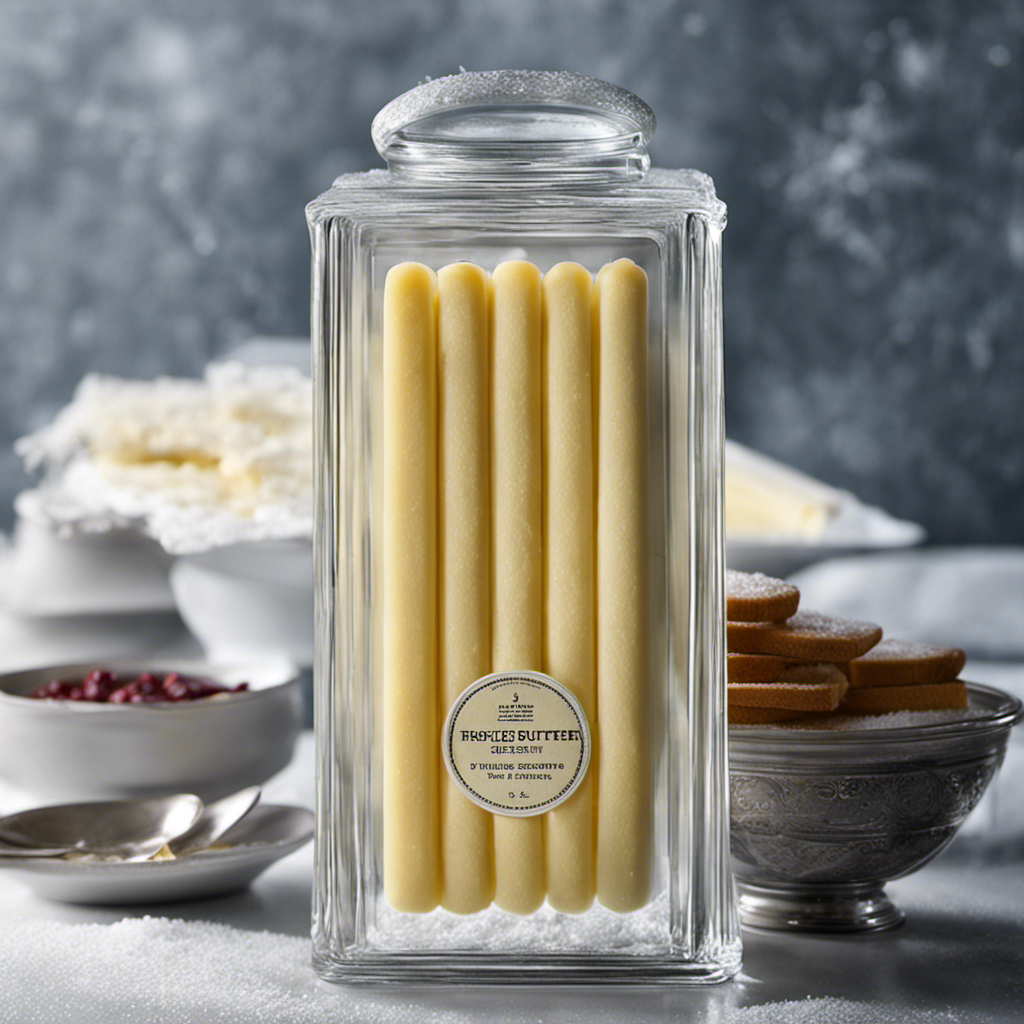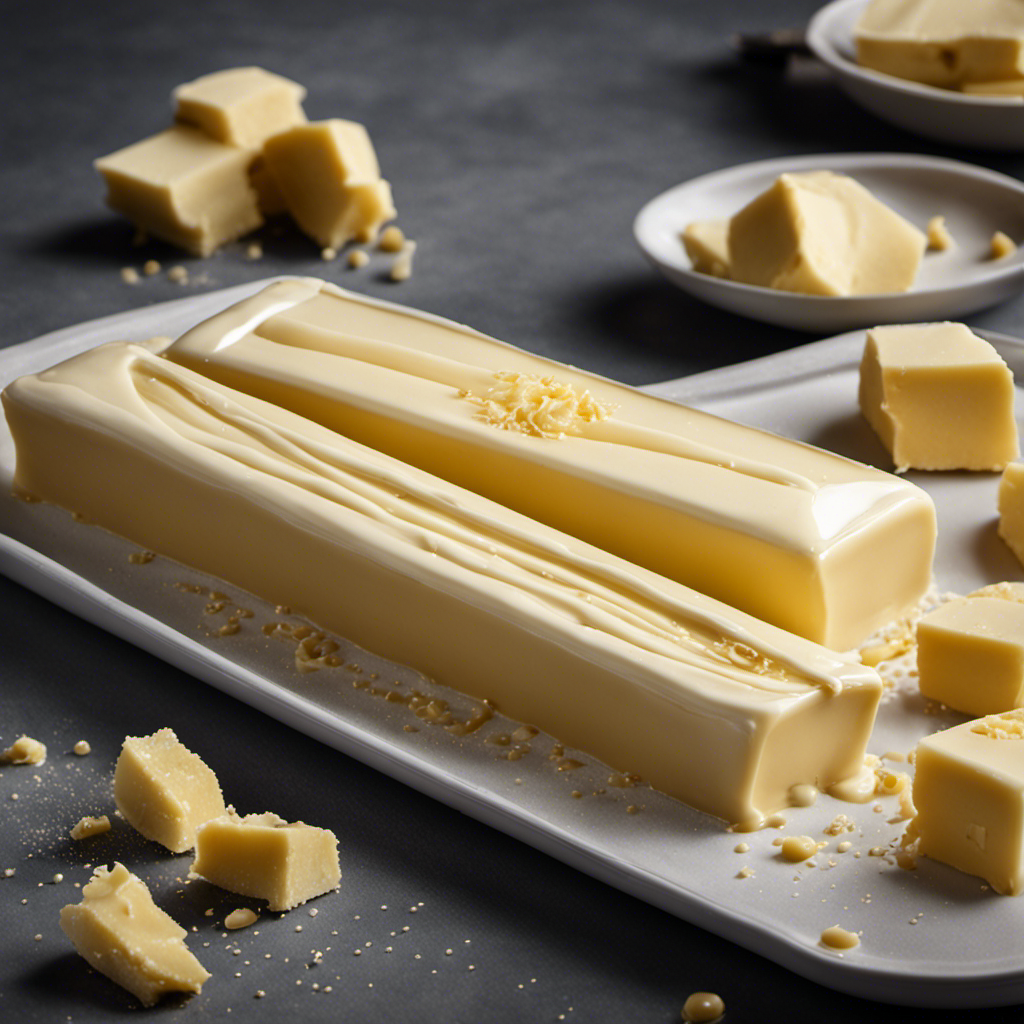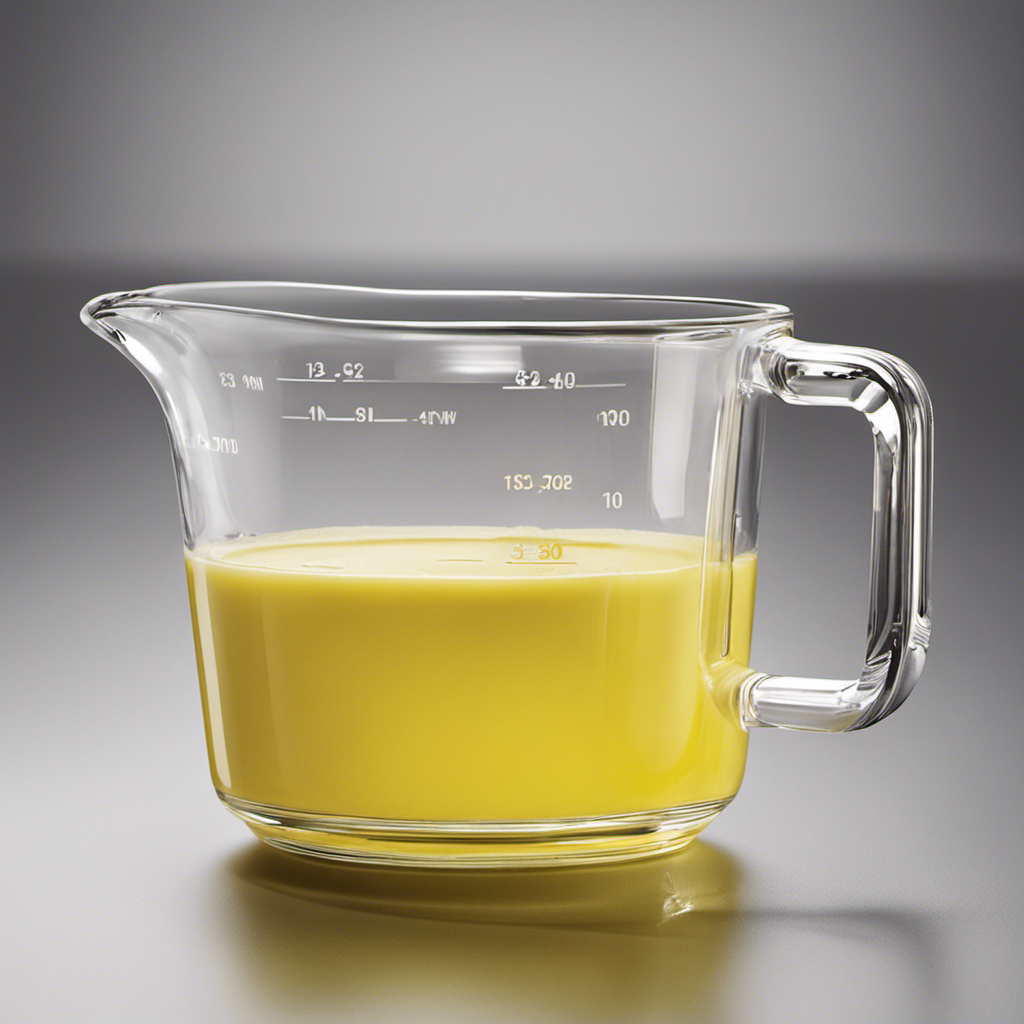As someone who proudly claims to be passionate about butter, I frequently catch myself contemplating the lifespan of my frozen butter supply. In this piece, I aim to explore the intricacies of storing butter in its frozen state, illuminating the elements that influence its durability and offering advice on optimal freezing durations.
Additionally, I will equip you with the knowledge of how to identify signs of spoilage and expert tips for properly thawing this golden delight.
Let’s embark on this buttery journey together!
Key Takeaways
- Frozen butter can be stored for up to six months when properly packaged.
- The recommended freezing time for unsalted butter is 9 months, salted butter is 6 months, and clarified butter is 12 months.
- Signs of spoilage in frozen butter include a rancid smell, changes in color or texture, and mold growth.
- Thawed butter can be used for spreading, cooking, and adding flavor to various recipes.
Storage Guidelines for Frozen Butter
Frozen butter can be stored for up to six months when properly packaged. To ensure the quality and freshness of frozen butter, it is important to use airtight containers or freezer bags. This prevents the butter from absorbing any odors or flavors from other foods in the freezer. Wrapping the butter in aluminum foil or plastic wrap before placing it in the container can provide an additional layer of protection against freezer burn.
When it comes to alternative uses for frozen butter, there are plenty of options. It can be grated and used for baking or cooking, or even spread directly on toast or bread. The texture may change slightly after freezing, but the taste and functionality remain intact.
Factors Affecting the Shelf Life of Frozen Butter
One factor that affects the shelf life of frozen butter is moisture content. When butter is exposed to moisture, it can lead to the growth of bacteria and mold, which can spoil the butter faster. To ensure the longevity of frozen butter, it is important to consider the freezing temperature and the packaging materials used.
-
Freezing temperature: Butter should be stored at a temperature of 0°F (-18°C) or below. This low temperature helps to inhibit the growth of microorganisms and maintain the quality of the butter.
-
Packaging materials: It is recommended to use airtight and moisture-resistant packaging materials such as heavy-duty freezer bags or plastic wrap. These materials help to prevent freezer burn and keep the butter fresh for a longer period.
Considering these factors will help extend the shelf life of frozen butter, ensuring its quality and taste.
Now, let’s move on to discussing the recommended freezing time for butter.
Recommended Freezing Time for Butter
To ensure optimal results, you should freeze your butter for a recommended amount of time. The freezing duration plays a crucial role in maintaining the quality and freshness of the butter. When stored in the freezer, butter can typically last for 6 to 9 months before it starts to lose its flavor and texture. However, it is important to note that the freezing time can vary depending on the specific type of butter and the storage conditions. To help you understand the recommended freezing time for butter, I have prepared a table below:
| Type of Butter | Recommended Freezing Time |
|---|---|
| Unsalted Butter | 9 months |
| Salted Butter | 6 months |
| Clarified Butter | 12 months |
Signs of Spoilage in Frozen Butter
If you notice a strong rancid smell or a change in color or texture, it’s likely that your frozen butter has spoiled. Freezing butter is a great way to extend its shelf life, but it’s important to know when it has gone bad. Here are some signs of spoilage to look out for:
-
Rancid smell: A strong, unpleasant odor is a clear indication that the butter has spoilt.
-
Change in color: If the butter has turned noticeably darker or has developed green or gray spots, it’s a sign of spoilage.
-
Texture changes: Frozen butter should maintain its firmness and smooth texture. If it becomes grainy, crumbly, or develops a watery or slimy consistency, it has likely spoiled.
-
Mold growth: If you spot any mold on the butter, it’s a definite sign that it’s no longer safe to consume.
Tips for Properly Thawing Frozen Butter
When thawing frozen butter, make sure to take it out of the freezer and leave it on the counter for a few hours until it becomes soft and spreadable. This is the most common and effective method for thawing butter.
However, there are other thawing techniques you can try if you’re short on time. One alternative method is to place the butter in a microwave-safe dish and defrost it using the microwave’s low power setting. Be sure to check on it frequently to avoid melting.
Another option is to grate the frozen butter using a cheese grater, which will help it thaw quickly and evenly.
Thawed butter can be used in various ways, such as for spreading on toast or adding to baked goods. It can also be melted and used for cooking or as a delicious topping for popcorn.
With these thawing techniques and alternative uses, you can make the most of your frozen butter.
Frequently Asked Questions
Can I Refreeze Butter That Has Been Thawed?
Yes, you can refreeze butter that has been thawed. To prevent spoilage, store butter in an airtight container or wrap tightly in plastic wrap. This will help maintain its quality and extend its shelf life.
How Can I Prevent Freezer Burn on My Frozen Butter?
To prevent freezer burn on frozen butter, I recommend storing it in an airtight container or wrapping it tightly in plastic wrap before placing it in the freezer. This will help maintain its quality and freshness for longer periods of time.
Can I Freeze Butter in Its Original Packaging?
Freezing butter in its original packaging can lead to freezer burn. It’s best to wrap it tightly in foil or plastic wrap before freezing. As for how long it takes to soften at room temperature, it usually takes around 30 minutes.
Can I Freeze Salted and Unsalted Butter for the Same Amount of Time?
I’m not sure about the difference in freezing times between salted and unsalted butter. However, I can tell you that freezing butter is a great way to extend its shelf life.
How Long Does It Take for Frozen Butter to Reach Room Temperature When Thawing?
When thawing frozen butter, it usually takes about 1-2 hours to reach room temperature. The best thawing method is to place it in the refrigerator overnight. This allows for gradual thawing and maintains its quality.
Conclusion
In conclusion, frozen butter can be stored for up to 6 months without significant loss in quality. However, it is important to consider factors such as proper packaging and temperature control to ensure its freshness.
Just like a well-preserved treasure, frozen butter can be a valuable asset in your kitchen, adding richness and flavor to your culinary creations. So, make sure to follow the recommended freezing time and thawing methods to unlock the full potential of this golden delight.









